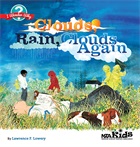Earth Science Week Resources from the National Science Teachers Association
By Lauren Jonas, NSTA Assistant Executive Director
Posted on 2013-10-11
Earth Science Week is October 13–19, 2013. Take a world tour, solve a mystery, apply to be named the Environmental Science Educator of the Year, or delve into an entire year’s worth of lessons with this resource collection from the National Science Teachers Association (NSTA).
Elementary Resources
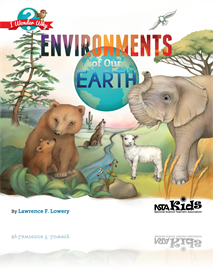 Environments of Our Earth: I Wonder Why: Take a world tour between the covers of a book! Environments of Our Earth guides children through six types of regions that are shaped by rainfall—or the lack thereof. Readers take a journey that starts with dense tropical rainforests and woodlands, travels through grassy savannas and prairies, and ends at dry steppes and deserts. [Read a free sample, or browse all of our kids books, many of which are also appropriate for Earth science week.]
Environments of Our Earth: I Wonder Why: Take a world tour between the covers of a book! Environments of Our Earth guides children through six types of regions that are shaped by rainfall—or the lack thereof. Readers take a journey that starts with dense tropical rainforests and woodlands, travels through grassy savannas and prairies, and ends at dry steppes and deserts. [Read a free sample, or browse all of our kids books, many of which are also appropriate for Earth science week.]
The Dynamic Earth: Recycling Naturally! This free article from the NSTA journal Science and Children provides a series of learning cycle lessons that put a new spin on rock formation.
Everyday Earth and Space Science Mysteries: What are the odds that a meteor will hit your house? Do you actually get more sunlight from Daylight Saving Time? Where do puddles go? By presenting everyday mysteries like these, this book will motivate your students to carry out hands-on science investigations and actually care about the results. [Read a free chapter: The Little Tent That Cried]
Bringing Outdoor Science In: Thrifty Classroom Lessons: When it’s just not possible to take students out to explore the natural world, bring the natural world to the classroom. Clearly organized and easy to use, this helpful guide contains more than 50 science lessons in six units: Greening the School, Insects, Plants, Rocks and Soils, Water, and In the Sky. [Read a free chapter: Rocks and Soils]
Middle School Resources
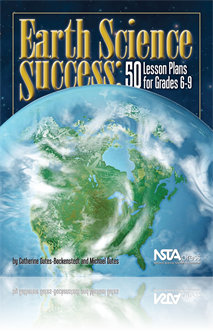 Earth Science Success: 50 Lesson Plans for Grades 6–9: Designed as a ready-to-use survival guide for middle school Earth science teachers, this book is an invaluable resource that provides an entire year’s worth of inquiry-based and discovery-oriented Earth science lessons, including 33 investigations or labs and 17 detailed projects. [Read a free chapter: Meteorology]
Earth Science Success: 50 Lesson Plans for Grades 6–9: Designed as a ready-to-use survival guide for middle school Earth science teachers, this book is an invaluable resource that provides an entire year’s worth of inquiry-based and discovery-oriented Earth science lessons, including 33 investigations or labs and 17 detailed projects. [Read a free chapter: Meteorology]
Generating Arguments about Climate Change: In this free article from the journal Science Scope, students participate in a unit on global climate change by engaging in the process of scientific argumentation. The lessons presented in this article were created using the generate-an-argument model to help students understand climate change science.
Project Earth Science: Geology, Revised 2nd Edition: Involve students in activities that focus on how plate tectonics explain characteristics and features of Earth. The 15 hands-on, teacher-tested, classroom activities in this book use readily available materials and provide straightforward and up-to-date explanations of geologic processes and cycles.
High School Resources
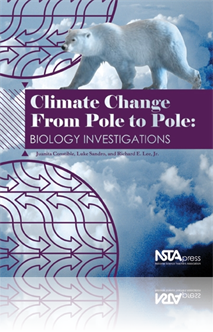 Climate Change From Pole to Pole: This volume provides an authentic and rigorous way to engage students in science and environmental issues—scientific methods, evidence, climate, and biological effects of climate change—and is a unique and essential resource for your high school or college-level classroom.
Climate Change From Pole to Pole: This volume provides an authentic and rigorous way to engage students in science and environmental issues—scientific methods, evidence, climate, and biological effects of climate change—and is a unique and essential resource for your high school or college-level classroom.
Citizen Scientists: Investigating Science in the Community: This free article from The Science Teacher journal describes numerous examples of citizen science projects that provide meaningful, authentic contexts for students to engage in the processes of science.
Earth Science Puzzles: Making Meaning From Data: Teachers of Earth and environmental sciences in grades 8–12 will welcome this activity book centered on six “data puzzles” that foster critical-thinking skills in students and support science and math standards.
Citizen Science: 15 Lessons That Bring Biology to Life, 6–12: Citizen Science offers you real-life case studies of classes that engaged in citizen science and learned authentic scientific processes and the habits of mind associated with scientific reasoning. The volume has plenty of flexibility, so you can use the lessons with or without access to field or lab facilities; whether or not your students can collect and submit data of their own; and inside your classroom or outside through fieldwork in schoolyards, parks, or other natural areas in urban or rural settings. [Read a free chapter: Bird Migration Patterns in My Area]
General Support for K-12 Educators
Apply for the SeaWorld Parks & Entertainment Outstanding Environmental Science Educator of the Year Award: This $10k award recognizes the outstanding efforts of students, teachers, and community leaders across the country, who are working at the grass roots level to protect and preserve the environment. The winner will receive $10,000 and an expense paid trip to attend the NSTA National Conference. The deadline is November 30, 2013. Find a complete application and more information here.
Earth, Sun, and Moon: General Characteristics of Earth: This FREE, two-hour, online interactive inquiry-based content module helps teachers better understand the science content they teach. This Science Object is the first of four Science Objects in the Earth, Sun, and Moon SciPack. It provides an understanding of how the different spheres (atmosphere, lithosphere, and hydrosphere) of Earth interact and why each plays an important role in making Earth the only planet with the conditions necessary for life. Earth is approximately spherical in shape like all planets and stars. Earth is composed mostly of rock. Three-fourths of its surface is covered by a relatively thin layer of water (some of it frozen), and the entire planet is surrounded by a relatively thin blanket of air.
Looking for more? Search among more than 6,000 resources, quality professional development opportunities (many of which are free), and management and reporting tools. The NSTA Learning Center can help with your professional development needs. To check out The NSTA Learning Center, click here.
Earth Science Week is October 13–19, 2013. Take a world tour, solve a mystery, apply to be named the Environmental Science Educator of the Year, or delve into an entire year’s worth of lessons with this resource collection from the National Science Teachers Association (NSTA).
Elementary Resources
PreK–8 Science: A Playground for Literacy and Mathematics: Featured Strand at NSTA Conference in Denver, CO, December 12-14
By Lauren Jonas, NSTA Assistant Executive Director
Posted on 2013-10-07
This December, the National Science Teachers Association (NSTA) will feature a special strand “PreK–8 Science: A Playground for Literacy and Mathematics” at our Conference on Science Education in Denver, CO, December 12-14. Classrooms are the playgrounds that challenge and excite children. Science gives students a relevant and engaging purpose for reading, writing, and problem solving. Research shows that the integration of science and literacy enhances the learning of preK–8 students. As reflected in the CCSS and NGSS, integrating science into literacy and mathematics instruction improves students’ thinking skills.
Sessions organized around this strand include a featured presentation on Friday, December 13, 9:30–10:30 a.m. (“Play and Science Running Together”) by Kenneth Wesson (Educational Consultant, Neuroscience: San Jose, CA). More sessions on PreK–8 Science include the following:
- Using Graphs to Organize Data
- S’COOL: Making Cloud Observations from the Playground
- How Does Your Garden Grow?
- Bringing Science to Life! Using Invertebrates to Enhance Classroom Teaching
- Make-and-Take: Science, Literacy, and Math
- Let’s Get Physical: Force and Motion
- Sensational Science: Step-by-Step Strategies Across the Curriculum
- SMILE with Physical Science
- Engaging Children in Scientific Explanation: Connecting Science and Literacy Using a “Question-Claim-Evidence-Reason” Framework
Want more? Check out more than 400 sessions and other events with the Denver Session Browser/Personal Scheduler at http://www.nsta.org/conferences/area3.aspx.
This December, the National Science Teachers Association (NSTA) will feature a special strand “PreK–8 Science: A Playground for Literacy and Mathematics” at our Conference on Science Education in Denver, CO, December 12-14. Classrooms are the playgrounds that challenge and excite children. Science gives students a relevant and engaging purpose for reading, writing, and problem solving. Research shows that the integration of science and literacy enhances the learning of preK–8 students.
Citizen Science: Engaging Students Through Public Collaboration in Scientific Research
By Carole Hayward
Posted on 2013-10-07
 Too often, students think of science as a static collection of facts rather than an ongoing process of discovery in which they can play a part. Citizen science offer opportunities for students to engage in authentic investigations. Citizen science activities vary widely, depending on goals of the project and interests of individual participants. In Citizen Science: 15 Lessons That Bring Biology to Life, 6-12, editors Nancy Trautmann, Jennifer Fee, Terry Tomasek, and NancyLee Bergey present case studies that present specific ways to build citizen science data collection and analysis into your science teaching.
Too often, students think of science as a static collection of facts rather than an ongoing process of discovery in which they can play a part. Citizen science offer opportunities for students to engage in authentic investigations. Citizen science activities vary widely, depending on goals of the project and interests of individual participants. In Citizen Science: 15 Lessons That Bring Biology to Life, 6-12, editors Nancy Trautmann, Jennifer Fee, Terry Tomasek, and NancyLee Bergey present case studies that present specific ways to build citizen science data collection and analysis into your science teaching.
As the editors explain,
“Citizen science offers teachers a way to motivate and inspire students through participation in research that is relevant both locally and globally. Students build meaningful connections to the natural world as they make observations, collect data, and view their findings within the broader scope of the project. When students design and conduct their own investigations, they also build science practice understandings and analytical reasoning skills through their involvement in citizen science.”
Citizen science refers to efforts in which volunteers partner with professional scientists to collect to analyze data. Students, the general public, and even professional scientists can all be citizen scientists. The word citizen conveys the idea that anybody can participate in the collective enterprise of science, just as all citizens in a democracy are invited to vote and otherwise collaborate in building their government.
Perhaps the most common activity of citizen science is data collection. Beyond collecting information on individual species or groups, citizen scientists also monitor environmental conditions such as water quality. Participants in some projects contribute to scientific discoveries by helping to analyze what would otherwise be unmanageable amounts of data.
The 15 lessons in this book portray a rich diversity of ways in which students can both contribute to citizen science and make productive use of its outputs, learning science and math through working with real data and engaging in authentic practices of science. Whether the lesson plans is Turtle Trackers, Winter Twig Investigation, Bird Migration Patterns in My Area, or one of the many others that were selected through a competition for high-quality lessons, what better way to fulfill the NGSS mandate to couple science practice with content and give students a real-world context in which to apply what they are learning?
This book is also available as an e-book.
Chemistry: Strategies and activities
By Mary Bigelow
Posted on 2013-10-06
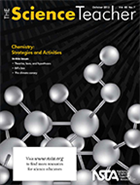
October — The school year is well underway and it’s the month in which science teachers celebrate Mole Day (so who needs Halloween to have some fun?) It’s also the month for featured articles on chemistry.
Theories, Laws, and Hypotheses* should be required reading for all science teachers! Using the gas laws that many of us have in our curriculum, the authors address misconceptions that students and many adults have about the terms and how these terms are misused. The article has examples of laws and theories, and if you’re unsure about the terms, this is a good resource. [SciLinks: Gas Laws]
Many teachers use analogies to make abstract concepts more concrete, especially for students who are new to a concept. From Cars to Creatures describes how the use of analogies could be applied to concepts such as plate tectonics (comparing to fingernail growth), biological niches (comparing to types of cars), and stratigraphy (comparing to layers of a sandwich). The authors note that “asking students to describe aspects of the analog that are and are not accurate represenations of the target science topic…promotes higher-order thinking…” [SciLinks: Niches, Plate Tectonics, Stratigraphy]
What chemistry teacher among us has had students struggle with stoichiometry? NSTA’s chemistry list serve often has questions about this topic. Bill’s Box has a teacher-tested strategy for helping students with five types of stoichiometry problems, including examples. . The strategies use an analogy of building a tricycle and has suggestions for applying that concept to chemistry. [SciLinks: Stoichiometry]
Students often can plug in values and produce answers, but they don’t always understand what the process and the solutions actually mean. The authors of All Screwed Up* share an activity that can lead to a deeper understanding of chemistry concepts. Nuts and bolts from a hardware store are used to illustrate chemical kinetics and the basics of collision theory. The article includes teaching tips, examples of collected data, and suggestions for connecting the activity to the concepts. [SciLinks: Chemical Reactions]
As the authors of Antarctica’s Pine Island Glacier: A “Climate Canary”?* state: “Learning directly from data is powerful.” They describe a 2-3 day lesson in which students use real data to construct and use models to study the changes that are taking place in polar environments. [SciLinks: Polar Climate, Climate Change]
Check out the monthly columns for faculty meeting discussion-starters:
- Science 2.0: What keeps kids (and adults) engaged for hours? Designing Your Course Like a Video Game examines gaming features such as levels of challenges, quests, feedback, and the option to start over.
- The Green Room: Good Ozone, Bad Ozone addresses a misunderstanding that students may have about this atmospheric gas. [SciLinks: Ozone Depletion, Greenhouse Gases]
- New Teacher’s Toolbox: Is That the Teacher? has suggestions for setting boundaries and transitioning from college student to professional.
- Safer Science: Safety to the Wind looks at ventilation standards for science labs.
*Don’t forget to look at the Connections for this issue (October 2013). Even if the article does not quite fit with your lesson agenda, this resource has ideas for handouts, background information sheets, data sheets, rubrics, etc.

October — The school year is well underway and it’s the month in which science teachers celebrate Mole Day (so who needs Halloween to have some fun?) It’s also the month for featured articles on chemistry.
October K-12 Journals Available from the National Science Teachers Association
By Lauren Jonas, NSTA Assistant Executive Director
Posted on 2013-10-05
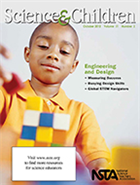 October’s K–12 journals from the National Science Teachers Association (NSTA) highlight unique trends in science eduction.
October’s K–12 journals from the National Science Teachers Association (NSTA) highlight unique trends in science eduction.
Science and Children, for elementary educators, hones in on one of the major shifts in the Next Generation Science Standards—the significant focus on engineering. This issue provides several approaches that can be used to support elementary students as they delineate problems, design solutions, and optimize their design solutions. Check out this free article to get a sense of the issue: Wacky Weather.
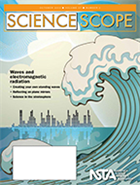 Science Scope, for middle level and junior high school science teachers, takes on the misconceptions students have about waves and electromagnetic radiation. To make sure you and your students are on the same wavelength when confronting these concepts, check out the collection of activities in this month’s issue. We’re sure they’ll spread the full spectrum of light on the world of waves. The following free article Reflecting Understanding: Using Lab Stations to Teach Image Formation is available from the issue.
Science Scope, for middle level and junior high school science teachers, takes on the misconceptions students have about waves and electromagnetic radiation. To make sure you and your students are on the same wavelength when confronting these concepts, check out the collection of activities in this month’s issue. We’re sure they’ll spread the full spectrum of light on the world of waves. The following free article Reflecting Understanding: Using Lab Stations to Teach Image Formation is available from the issue.
 The Science Teacher, NSTA’s high school level journal, clarifies how the Next Generation Science Standards (NGSS) establish performance expectations for students that integrate three important dimensions—science and engineering practices, disciplinary core ideas, and crosscutting concepts—and incorporate important concepts of engineering. Maintaining a teachable number of core ideas was clearly a priority for the NGSS writers. For example, only eight high school level performance expectations directly relate to chemistry. Teachers can help students reach expectations by using the core ideas with a variety of instructional practices. This issue brings together several articles on chemistry that will help science teachers meet the challenges of today’s classroom. This month’s free article All Screwed Up can be accessed online.
The Science Teacher, NSTA’s high school level journal, clarifies how the Next Generation Science Standards (NGSS) establish performance expectations for students that integrate three important dimensions—science and engineering practices, disciplinary core ideas, and crosscutting concepts—and incorporate important concepts of engineering. Maintaining a teachable number of core ideas was clearly a priority for the NGSS writers. For example, only eight high school level performance expectations directly relate to chemistry. Teachers can help students reach expectations by using the core ideas with a variety of instructional practices. This issue brings together several articles on chemistry that will help science teachers meet the challenges of today’s classroom. This month’s free article All Screwed Up can be accessed online.
 October’s K–12 journals from the National Science Teachers Association (NSTA) highlight unique trends in science eduction.
October’s K–12 journals from the National Science Teachers Association (NSTA) highlight unique trends in science eduction.
iBooks Author
By Ken Roberts
Posted on 2013-10-03
One of Apple’s more recent releases may cause problems in your classroom: You and your students will be fighting over it to see who can create the splashiest electronic books! Given Apple’s remarkable success with its iPad, the company has moved even further into the education market with electronic books that can be read on these popular devices— and now, anyone can “write” books for the iPad, which can exploit the tablet’s many multimedia and sense-jarring capabilities. Apple’s iBooks Author application (app) is a free piece of software that allows you to create multi-touch textbooks that use, among many other things, video, interactive photo galleries, voiceovers, diagrams and tables, and 3-D objects. You will have to author your book on a Mac computer loaded with the appropriate operating system; however, you can then download your creation to any or all of the iPads in your school that have the most recent version of iBooks (currently 3.0) installed.
Using this combination of tools to create books about science topics or lab exercises, you or your student can develop digital books that others can load onto their own devices for studying and sharing. You can also project the books during lessons year after year or offer them to parents to help their children do homework exercises. While these books are likely to be the hit of the school, they can only be enjoyed on an iPad (and not other electronic readers), and they won’t play on iPods or iPhones. Beyond these limitations, you and your students are likely to view yourselves as combinations of Ernest Hemingway, Lady Gaga, and Steven Spielberg! Since Apple’s motive for this development is to join the growing business of electronic textbook development, textbooks created by iBooks Author may only be sold if they are accepted and distributed by Apple; however, teachers have a more realistic option of releasing their work locally and without any paperwork if the book is distributed for free. This means that you can join the party now, sidestepping issues of cost and copyright contracts while keeping all of the creative energies in your school building. To leap into this exciting fray, your Mac operating system needs to be OS X 10.6.6 or higher. You can then download the latest version of the Apple iBooks Author app (currently version 2.0) for free from the Apple store.
To begin a project, you are likely going to want to create your text before you start designing the book in iBooks Author; given that you simply “pour” text into the various portions of your book, you will also want your chosen visuals and other interactive elements to be ready to use. Similarly, if you want to insert a series of photos or one or more slide-show presentations, these should be created in advance. Your work area will appear much like the one shown in Figure 1.
If you are familiar with Mac iWorks, Apple’s productivity suite, you will feel right at home using iBooks Author. As with other iWorks programs, you begin with a choice of six templates, from which you can create attractively formatted e-books, or you can generate your own. To create simple books, either the Basic template or the Modern Type template will serve you well. However, for a richer array of design features, iBooks Author offers three templates, Editorial, Contemporary, and Craft, all of which include several opportunities for including photos or visual images that add a “wow” factor to your book. Alternatively, you can create your own custom template, which could include your school’s signature layout; that template can then be used in the future if you or your colleagues want to publish more books. After selecting your template, you can begin the fun work of filling in the pages with the text that you or your students have created for this purpose. It is as simple as clicking and pasting.
With that task complete, you will see the menu bar, which allows you to manipulate the text and add electronic text features such as callouts, shapes, and even data tables and charts from your lab exercises (see Figure 2).
You will soon discover how the software accommodates your insertions by flowing text around each addition. These additions can include photos, some of which fit neatly into template holding points, or you can drag and drop them into any location you choose. You are likely to find yourself experimenting with all sorts of variations in appearance; the changes are all done on the fly as your whim dictates. In no time, you will find your chapter taking shape, and you can then use the Add Pages feature to create a new chapter or section in the book.
The glitzy elements of your creation are likely to come from the Widgets feature, which brings even greater interactivity and visual splash to the reading experience. Widgets allows you to create energy-charged elements within the book, using the following star performers: Gallery, Media, Review, Keynote, Interactive Image, 3-D, and HTML (see Figure 3).
For example, if you have developed your own photo collections related to particular teaching units, you can use the Gallery option to insert a series of photographs that readers navigate by using their fingers to sweep through the image sequence, each with its own caption; for the student, the experience is much like viewing a photo album. Similarly, videos and YouTube clips, as well as audio clips, can be included in your book by using the Media widget, which can provide an option for students who require a scaffold to their reading experience. The only caveat here is that you must be sure that the videos are first converted into Apple’s preferred formats of M4V for video and M4A for audio (which can be done in iTunes). Using another Widget option, you can insert an entire slide presentation imported directly from Apple’s Keynote program, and your readers can move through each of the slides at their own pace as an optional part of their reading.
Two other Widgets that are particularly powerful for enticing young readers are the Interactive Image and the 3-D options. The Interactive Image feature enables you to produce “zoomable” visual images, which readers touch to zoom in for inspection at closer range. This same feature allows you to add labeled points to the image so that the reader can tap a label to view its complete description; a label can be made as large as you wish to make it, and it is easy to navigate from label to label. These capabilities are the dream of a frustrated teacher of lab activities.
Additionally, if you feel that a 2-D image is insufficient to convey your point, you can include a 3-D image that the reader will be able to rotate in various directions. To use the 3-D widget tool, you must have access to 3-D images. The SketchUp 3-D Warehouse (www. sketchup.com/products/3D-warehouse) is a great online archive of free 3-D images that you can insert into your new iBook. Once you have located the image you want to use, you’ll need to save the file in the COLLADADAE format using the drop-down “Download Image” menu. Once saved, the image is ready to be imported into your iBook. You can monitor your progress as you build your book by having your iPad connected to your Mac with the usual iPad USB connector cable. To double-check the appearance of your book on the iPad as you work on the Mac, click on the Preview button. When you have completed your masterpiece, you can hand off the finished product to the iPad. Similarly, you can pass your book to other students’ iPads through iTunes. Additionally, for those students who do not have an iPad, you can give your manuscript to them by creating a PDF version; however, the interactivity will be lost with this last option.
Your teacher’s instinct will appreciate that the good news continues when students are viewing your work on the iPad itself; there are additional academically useful options built into iBooks, Apple’s electronic reader app. For example, students can access an array of options that appear when they tap on a word: Define, Highlight, Note, or Search. The Define feature gives students the definition of a word as well as option to search the web or Wikipedia for a more detailed explanation. The Highlight feature allows students to highlight important terms or concepts using a variety of colors as they read, and just as students might like to use sticky notes as they read paper books, the Note option gives students the ability to jot down ideas or questions. Once notes are added, the text is marked with a small sticky note in the margin and the notes are saved for future reference. Finally, should students need to find a particular term or phrase, they can use the Search feature to zip through the book, including the media sections, for places where it appears. Taking it as a given that teachers would need to concern themselves with testing their students’ understanding of what they have read, the Apple designers have included another widget that allows you to insert a quiz anywhere in your creation. Called a Review, this option allows you to enter multiple-choice questions anywhere in the body of the text; by clicking on this icon, a box containing the multiple-choice quiz is inserted at a point of your choosing. If you like, you can have the quiz expand to a full-screen view. You write the question, create the answer options, and then select the correct answer, and you can create as many questions as you like. Note that you can also create variations that science teachers will love: questions can be built around an inserted image (of lab slides, for example), and questions can be crafted around the task of labeling specific points in an image (of zygotes, for example). A summary of students’ correct responses is provided onscreen.
The sale of iPads continues to soar at an astonishing rate, and Apple has become an enormous market force. Not only are lots of families buying iPads, approximately 1.5 million of the devices are estimated to be in use in schools today. Clearly, Apple is envisioning a much wider use of electronic texts in schools, but it also has its eye on establishing a place in the textbook market with less expensive, more feature-rich textbooks. And you can have a piece of the action! Imagine students studying from books that they and you have created together, and imagine the collection of electronic textbooks that you can develop for subsequent years’ students.
One of Apple’s more recent releases may cause problems in your classroom: You and your students will be fighting over it to see who can create the splashiest electronic books! Given Apple’s remarkable success with its iPad, the company has moved even further into the education market with electronic books that can be read on these popular devices— and now, anyone can “write” books for the iPad, which can exploit the tablet’s many multimedia and sense-jarring capabilities.
Using "kits" in science
By Mary Bigelow
Posted on 2013-10-02
 I’m a second-year teacher at a small elementary school. I was poking around the supply closet and found several unopened science kits. Last year, I did some basic science activities that I did while student teaching, but this year, I’d like to do more. Would these kits be helpful? What do I need to know about them?
I’m a second-year teacher at a small elementary school. I was poking around the supply closet and found several unopened science kits. Last year, I did some basic science activities that I did while student teaching, but this year, I’d like to do more. Would these kits be helpful? What do I need to know about them?
—Conrad, South Bend, Indiana
I’m glad you’re expanding your lessons to incorporate more science investigations. Science kits are published by many companies and individuals and address a variety of topics. They can be helpful for teachers who do not have a lot of background experience in science topics–either in the content itself or in designing and implementing inquiry-based activities.
I’d ask your colleagues or department chair what they know about them. And then, go ahead and open the boxes! Take a look at the descriptions and the teacher’s guides and check out information on the publisher’s website. Most kits focus on a theme or topic (e.g., the human body, matter and energy, weather). Determine which topics and lessons align with your curriculum goals. The kits I’m familiar with contain several lessons and are designed to be used as a unit of instruction at specific grade levels (e.g., K-2, 3-5, 6-8).
In addition to a teacher’s guide, the kits should also include student handouts and basic materials the students need for the activities. The activities should promote processes such as observing, questioning, hypothesizing, predicting, investigating (including planning, conducting, measuring, gathering data, controlling variables, interpreting, and drawing conclusions), and communicating. If the kits are just a collection of materials for demonstrations or replication (sometimes referred to as “cookbook” activities), you’ll need to go beyond showing students how to follow directions and supplement the activities with additional strategies in the processes mentioned above.
The kits should also have assessment suggestions, rubrics, timelines for implementation, suggestions for interdisciplinary connections, and components for reading, writing, and mathematics. Using kits should be an integral part of your science program, not an add-on, so be sure to allow time for all of the activities (anywhere from a few weeks to an entire marking period may be needed). The kits I’m familiar with do not have rigid scripts, so the teacher can adapt the activities to the needs and interests of the students.
When schools purchase kits, there is often an option for teacher training/professional development in using them. But unfortunately, you didn’t have that opportunity. If the publisher has a website, use it to learn more about the topics and the materials. Take advantage of any online forums or Frequently Asked Questions.
I worked with a fourth-grade teacher who used a kit focused on the anatomy and physiology of the human skeletal and muscular systems. When I observed her classes, the students made models of the human arm, using craft sticks and rubber bands. But this wasn’t just an arts-and-crafts replica. The students then used their models to explore the relationship between muscles, bones, and ligaments. When a group asked, “What would happen if the rubber bands were shorter?” the teacher asked what they thought would happen and encouraged them to change their model to see what did happen. As students worked, she distributed (without comment) pictures of animal skeletons. When the students looked at bird and bat wings, the arms of humans and apes, and the legs of frogs, horses, and cats, you could see light bulbs go off over their heads. “Wow, look how these are all alike!” “So that’s what the bones in a Buffalo wing are.” “The bones in our arms and legs are similar.” The teacher did not have to tell the students about homologous structures—the students saw them and came up with their own examples. Several students looked up and learned the names of the bones, even though that was not an essential goal of the unit.
Another consideration is to inventory and replenish any materials in the kit before you store it again. You’ll be all ready for the next time.
This can be a great opportunity to get inquiry science into your classrooms. Just remember: although inquiry-based science often involves hands-on activities, not all hands-on activities are inquiry-based.
Photo: http://farm8.staticflickr.com/7007/6799976179_7f6b4eecb4_q.jpg
 I’m a second-year teacher at a small elementary school. I was poking around the supply closet and found several unopened science kits. Last year, I did some basic science activities that I did while student teaching, but this year, I’d like to do more. Would these kits be helpful? What do I need to know about them?
I’m a second-year teacher at a small elementary school. I was poking around the supply closet and found several unopened science kits. Last year, I did some basic science activities that I did while student teaching, but this year, I’d like to do more. Would these kits be helpful? What do I need to know about them?
—Conrad, South Bend, Indiana
Assessments: Part of the learning process
By Mary Bigelow
Posted on 2013-09-29
 Do you have advice on assessments that would be helpful for sharing with my mentee, a new teacher?
Do you have advice on assessments that would be helpful for sharing with my mentee, a new teacher?
—Shirley, Lexington, Kentucky
Assessing student learning can (and should) include more than final tests. The process has components before, during, and at the end of the unit of instruction. You might find my archived posts with questions on assessments helpful:
Assessment at the beginning of a unit—Finding out what students know (or don’t know)
- Overcoming misconceptions Every year my students come to class with the idea that it’s colder in the winter because the earth is farther away from the sun. Where did they get this idea?
- What do students already know? Last year, I started giving pretests at the beginning of each unit. The students were upset because they didn’t know many of the answers, even though I explained I didn’t expect them to know everything and the pretest wouldn’t count as a grade. Are there other ways to find out what students know about a topic?
Assessment during the unit –- Helping students monitor their own learning, in addition to formative assessments
- Asking for help During class, students seem to understand the concepts. However, they don’t do well on the tests. I offer extra help before and after school and at lunch, but few students take advantage of it. I’m a first-year biology teacher, so I’d appreciate some suggestions on how to encourage students to ask questions or seek help when they need it.
- Student self-evaluation: How am I doing? My middle school students frequently ask me “Is this right?” or “What should I do now?” How can I help them become more self-reliant?
Assessment at the end of a unit—Going beyond multiple-choice questions
- Using essay questions I want to use more essay-type questions on my unit assessments, but with 150 students I feel swamped trying to grade all of the papers and provide feedback. Any suggestions for making this a good learning process?
- Rubrics I’m trying to use more projects and open-ended assessments this year, but I’m getting bogged down with grading them. I know I should use rubrics, but it’s hard to create them for every assignment. Any suggestions for streamlining this process?
And providing meaningful feedback to students is another component of assessment. Our department chair is encouraging us to add comments to student writing assignments. This sounds time-consuming; I have more than 100 students in my Earth science classes. Would students even read my comments on lab reports or term papers?
Above all, I’d emphasize to your mentee that assessment is more than coming up with numbers to average into a grade. Using a variety of assessment strategies can help both the students and the teacher determine to what extent the learning goals are being met.
Photo: http://www.flickr.com/photos/fontplaydotcom/504443770/
 Do you have advice on assessments that would be helpful for sharing with my mentee, a new teacher?
Do you have advice on assessments that would be helpful for sharing with my mentee, a new teacher?
—Shirley, Lexington, Kentucky
Assessing student learning can (and should) include more than final tests. The process has components before, during, and at the end of the unit of instruction. You might find my archived posts with questions on assessments helpful:
Understanding science
By Mary Bigelow
Posted on 2013-09-27
I’ve been a longtime fan of Understanding Science from the University of California Museum of Paleontology at Berkeley. It’s a comprehensive resource for learning more about the processes of science as used in the real world. The processes of science are represented as fluid and iterative, showing that science does not follow a structured recipe. The three main components of the website are Understanding Science 101, a “primer on the nature and process of science.” Another link leads to Teaching Resources, with grade-specific suggestions. And the Resource Library has sections on misconceptions and case studies as well as links to articles, tutorials, and interactives. If the first unit in your science textbook describes “THE” scientific method as a traditional, rigid flowchart, head to this site right away.
This is similar in design to Berkeley’s Evolution 101 website, another treasure of lessons and resources for K-12
As they say on TV informercials – But wait! There’s more…
 How Science Works has been adapted as an online course for middle- and high-school science educators to “broaden their own knowledge and understanding and to use with students, the course weaves together activities, videos, and classroom-ready materials into a primer on the process of science that includes exploration and discovery, testing ideas, community feedback and peer review, and benefits and outcomes.” The course is free and downloadable for iOS devices from iTunes.
How Science Works has been adapted as an online course for middle- and high-school science educators to “broaden their own knowledge and understanding and to use with students, the course weaves together activities, videos, and classroom-ready materials into a primer on the process of science that includes exploration and discovery, testing ideas, community feedback and peer review, and benefits and outcomes.” The course is free and downloadable for iOS devices from iTunes.
I’ve downloaded the course to my iPad (but you’ll need an Internet connection to access the videos and documents). The course has many similarities to the website, but it is designed as a focused learning tool. Each “lesson” includes an overview and links to the videos and articles related to the topic. At key places, the user is invited to reflect or describe their learning, using either the built-in notes or another personal journal or notebook. And there is a section on the connections between the NGSS and the course topics.
I could see this being used for independent study or by a study group (either in-person or online). And it’s FREE.
I’ve been a longtime fan of Understanding Science from the University of California Museum of Paleontology at Berkeley. It’s a comprehensive resource for learning more about the processes of science as used in the real world. The processes of science are represented as fluid and iterative, showing that science does not follow a structured recipe.
What are science teachers reading in September?
By Amy America
Posted on 2013-09-26
Check out this month’s most popular books, e-books, and children’s science trade books! Click over to our NSTA Recommends Catalog app to see what’s new. Between now and October 31, 2013, save $10 off your order of $40 or more of NSTA Press books by entering promo code SAVE10 at checkout through the online Science Store.
Most Popular NSTA Press Books
- Uncovering Student Ideas in Science, Volume 1: 25 Formative Assessment Probes
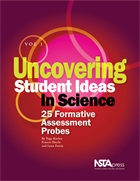
- The NSTA Reader’s Guide to the Next Generation Science Standards
- Citizen Science: 15 Lessons That Bring Biology to Life, 6-12
- Diagnosis for Classroom Success, Teacher Edition: Making Anatomy and Physiology Come Alive
- Even More Picture-Perfect Science Lessons: Using Children’s Books to Guide Inquiry, K–5
Most Popular NSTA Press e-Books
- Science for the Next Generation: Preparing for the New Standards
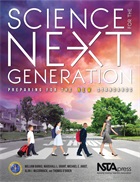
- Rise and Shine: A Practical Guide for the Beginning Science Teacher
- Predict, Observe, Explain: Activities Enhancing Scientific Understanding
- The Case for STEM Education: Challenges and Opportunities
- Uncovering Student Ideas in Primary Science, Volume 1: 25 New Formative Assessment Probes for Grades K–2
Most Popular Science Trade Books for Kids
Check out this month’s most popular books, e-books, and children’s science trade books! Click over to our NSTA Recommends Catalog app to see what’s new. Between now and October 31, 2013, save $10 off your order of $40 or more of NSTA Press books by entering promo code SAVE10 at checkout through the online Science Store.
Most Popular NSTA Press Books






